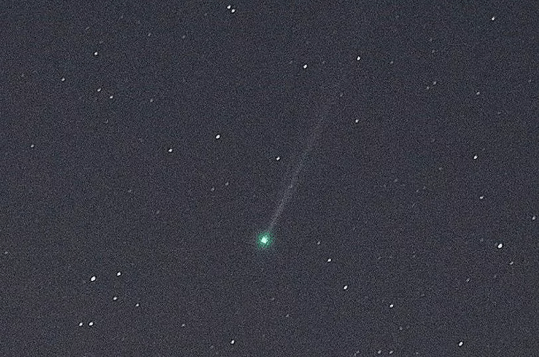A captivating celestial visitor is making its way towards the Sun, and it’s bringing an unmissable spectacle for UK stargazers.
If you’re wondering how to spot Comet SWAN in the UK, now is the perfect time to look up. Officially designated C/2025 F2 (SWAN), the dazzling green comet is currently visible from the northern hemisphere and is growing steadily brighter as it moves closer to the Sun.
This unique astronomical event provides a rare opportunity for observers across the UK to witness a comet glowing with a vivid green hue in the early morning sky.
How to Spot Comet SWAN in the UK This Week
The icy traveller was first detected by Michael Mattiazo, an amateur astronomer from Australia, who identified the bright object in images taken by the Solar Wind Anisotropies (SWAN) instrument aboard the European Space Agency’s SOHO spacecraft on 1 April.
Prior to receiving its official classification from the Minor Planet Center, the object was informally referred to as SWAN25F. Astronomers were intrigued to find the comet already shining at a notable magnitude of +10—unusual brightness for a newly detected body.
Photographed from Somerset
One UK observer, Josh Dury, aged 27, managed to capture Comet SWAN in striking detail from Somerset on Wednesday, 9 April. Using nine 60-second exposures, his images showcased the comet’s vivid green glow.
This characteristic colouring is produced by diatomic carbon—Dicarbon—releasing green light when exposed to solar radiation.
Best Times and How to View
Currently, the comet is shining at magnitude +8, which means it remains slightly too faint for the naked eye. Albert Zijlstra, Professor of Astrophysics at the University of Manchester, advises the use of binoculars for optimal viewing. “After April 22 or so it will be too close to the Sun to see.”
On the astronomical magnitude scale, a lower number indicates a brighter object. For example, Venus boasts a brilliance of -4. The green comet is expected to peak at around magnitude +4, potentially making it visible without aid in dark sky conditions.
According to BBC Sky at Night, this brightness peak will align with the comet’s perihelion—its closest approach to the Sun—on 1 May 2025, when it will pass within 31 million miles (50 million kilometres).
- Best Viewing Time: Around one hour before sunrise
- Direction: Look northeast
- Elevation: Approximately 10 degrees above the horizon
- Constellation: The comet will pass through Andromeda between 16–21 April
This viewing window is short-lived for northern observers. After 22 April, Comet SWAN will become too near to the Sun’s glare to be seen from the UK. However, skywatchers in the southern hemisphere may enjoy a better view as it continues its journey.
Even as Comet SWAN begins to fade from view, the heavens promise more wonders. The annual Lyrid meteor shower is forecast to reach its peak on 22 April. Experts recommend viewing the display during the pre-dawn hours, when up to 18 meteors per hour may streak across the UK sky.






